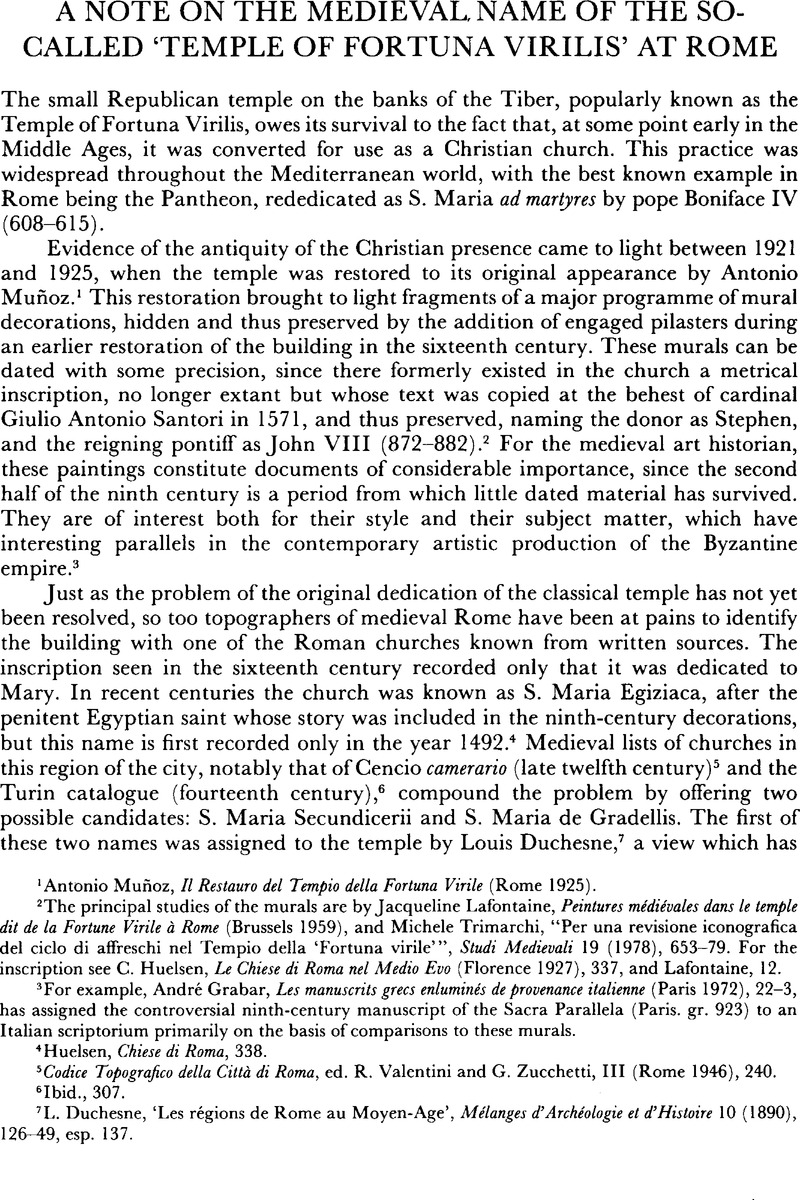Published online by Cambridge University Press: 09 August 2013

1 Muñoz, Antonio, Il Restauro del Tempio della Fortuna Virile (Rome 1925)Google Scholar.
2 The principal studies of the murals are by Lafontaine, Jacqueline, Peintures médiévales dans le temple dit de la Fortune Virile à Rome (Brussels 1959)Google Scholar, and Trimarchi, Michele, “Per una revisione iconografica del ciclo di affreschi nel Tempio della ‘Fortuna virile’”, Studi Medievali 19 (1978), 653–79Google Scholar. For the inscription see Huelsen, C., Le Chiese di Roma nel Medio Evo (Florence 1927), 337Google Scholar, and Lafontaine, 12.
3 For example, Grabar, André, Les manuscrits grecs enluminés de provenance italienne (Paris 1972), 22–3Google Scholar, has assigned the controversial ninth-century manuscript of the Sacra Parallela (Paris, gr. 923) to an Italian scriptorium primarily on the basis of comparisons to these murals.
4 Huelsen, , Chiese di Roma, 338Google Scholar.
5 Codice Topografico della Città di Roma, ed. Valentini, R. and Zucchetti, G., III (Rome 1946), 240Google Scholar.
6 Ibid., 307.
7 Duchesne, L., ‘Les régions de Rome au Moyen-Age’, Mélanges d'Archéologie et d'Histoire 10 (1890), 126–49CrossRefGoogle Scholar, esp. 137.
8 Marchetti-Longhi, G., ‘S. Maria ‘de Secundicerio’. Topografia medioevale di Roma’, Bullettino della Commissione Archeologica Comunale di Roma 54 (1927), 93–144Google Scholar; Cecchelli, C., ‘S. Maria delle Gradelle’, Studi e Documenti sulla Roma sacra I (1938), 241–58Google Scholar; and Trimarchi, 653–4.
9 Huelsen, C., ‘Di tre chiese medievali della Madonna nel rione Ripa’, Bullettino della Commissione Archeologica Comunale di Roma 53 (1926), 55–81Google Scholar, esp. 57–69; idem, Chiese di Roma, 336–8.
10 Muñoz, , Restauro, 13Google Scholar; Lafontaine, 9.
11 For example, Krautheimer, Richard, Rome: Profile of a City, 312–1308 (Princeton 1980), 167Google Scholar, and Ward-Perkins, Bryan, From Classical Antiquity to the Middle Ages. Urban Public Buildings in Northern and Central Italy A.D. 300–850 (Oxford 1984), 91Google Scholar.
12 The principal study of this office remains Galletti, Pierluigi, Del Primicero della Santa Sede Apostolica e di altri uffiziali maggiori del sacro palagio Lateranense (Rome 1776), 89–107Google Scholar.
13 Ibid., 99–100.
14 Monumenta Germaniae Historica. Epistolae VII (Munich 1978), 326–9Google Scholar. It is an interesting testimony to the anarchy then prevalent in the Roman campagna that John VIII laments that the conspirators, in escaping through the Porta S. Pancrazio on the Janiculum, left the gate unlocked, thus leaving the city vulnerable to infestation by the Saracens who controlled much of the countryside outside the walls. For the Saracen threat to Rome see Engreen, F. E., ‘Pope John the Eighth and the Arabs‘, Speculum 20 (1945), 318–30CrossRefGoogle Scholar. For the flight of the Formosan party see Llewellyn, Peter, Rome in the Dark Ages (London 1970), 281Google Scholar, and Devos, Paul, ‘Le mystérieux épisode final de la ‘Vita Gregorii’ de Jean Diacre. Formose et sa fuite de Rome’, Analecta Bollandiana 82 (1964), 355–81CrossRefGoogle Scholar.